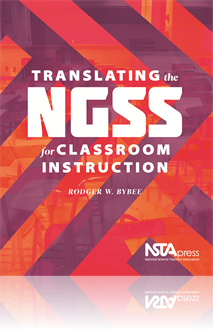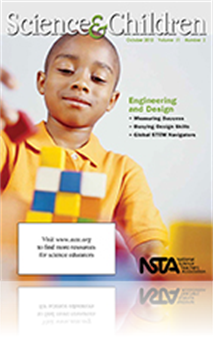All Resources
Book Chapter
From NGSS to Instruction in an Elementary Classroom
Implementing the standards does present significant challenges—the obvious and immediate challenge of classroom instruction. There also is the long-term challenge of contributing to students’ progressive understanding across the K–12 curriculum...
Book Chapter
From NGSS to Instruction in a Middle School Classroom
For middle school science teachers, one of the most fundamental changes involves curriculum, instruction, and assessments. This chapter uses performance expectations from the life sciences as the basis for a description of how Next Generation Science...
Book Chapter
From NGSS to Instruction in a High School Classroom
This chapter first presents performance expectations that describe the competencies and content for instruction and assessment in a high school biology class. This is followed by a description of a teaching sequence that integrates the practices, cor...
Book Chapter
The general purpose of education standards is to reset the goals for education, then make curriculum programs, classroom instruction, and education assessments more coherent through processes of reform. So, we have to begin as soon as possible (ASAP)...
Book Chapter
This chapter will help state science supervisors, district science coordinators, and school science teachers with the process of adapting instructional materials to accommodate the Next Generation Science Standards (NGSS). The science education comm...
Book Chapter
Planning to ADAPT Materials for Classroom Instruction
For this chapter, the goals are to identify the degree to which current instructional materials accommodate performance expectations from Next Generation Science Standards (NGSS) and to adapt these materials into a unit of instruction that is usable...
Book Chapter
NGSS Frequently Stated Concerns: The Yes, Buts
In this chapter, some of the Yes, but concerns are addressed. Some of the referents for the concerns lie beyond the Next Generation Science Standards (NGSS) and are the result of other variables, such as national politics, state budgets, or local pr...
Book Chapter
The Next Generation Science Standards (NGSS) raise the academic bar for states and still leave them with the freedom to adopt or adapt materials and provide professional development to attain higher levels of achievement—for all students. The NGSS...
Book Chapter
Appendix A: Grade 5 NGSS Unit, “Is It a New Substance?”
In this unit, students conduct an investigation to determine if two substances combine to form a new substance. The students mix Substance W with a solution of Substance X dissolved in water. They need to complete the investigation to gather evidence...
Book Chapter
Appendix B: Middle School NGSS Unit, “Water and Hydrogen Peroxide”
Water molecules and hydrogen peroxide molecules each consist of only hydrogen and oxygen atoms. A water molecule consists of two hydrogen atoms and one oxygen atom. A hydrogen peroxide molecule consists of two hydrogen atoms and two oxygen atoms. In ...
Book Chapter
Appendix C: High School NGSS Unit, “The Haber-Bosch Process”
A chemist named Fritz Haber developed a process to produce ammonia directly from hydrogen and nitrogen as shown in the equation. An engineer named Karl Bosch designed the equipment needed for the process, and today the Haber-Bosch process is the prim...
Book Chapter
From NGSS to Classroom Instruction
This chapter provides a context for translating standards into something understandable, manageable, and usable for those with the real task of teaching science. In the first sections, the chapter progresses from a brief discussion of the disciplinar...
Journal Article
An integrative science unit combines science content on severe weather with the engineering design process....
Journal Article
Straw Rockets Are Out of This World
STEM activities for upper elementary students....
Journal Article
Creative, inquiry-based lessons with buoys addressed STEM and science standards while promoting teamwork....
Journal Article
Developing project-based learning experiences helps students direct their learning....
Journal Article
An inquiry investigation about electromagnetism helps students understand and use scientific and engineering practices....
Journal Article
Second graders design, build, test, and improve tools to map a waterway....
Journal Article
Editor's Note: Engineering and Design
Science and Children’s editor shares thoughts regarding the current issue....
Journal Article
The Early Years: The STEM of Inquiry
This column discusses resources and science topics related to students in grades preK to 2. This month’s issue describes a STEM activity that includes designing and using a tool....
Journal Article
An opinion piece that aims to engage elementary teachers with key engineering components in the NGSS, including conceptual shifts, disciplinary core ideas, and practices to effectively wield the standards as a transformative tool for classroom instru...
Journal Article
Teaching Through Trade Books: Flying Machines
This column includes activities inspired by children’s literature. This month’s issue uses two fiction trade books to inspire students to design and test various flying machines....
Journal Article
Formative Assessment Probes: Pendulums and Crooked Swings: Connecting Science and Engineering
This column focuses on promoting learning through assessment. This month’s issue explores the complementary nature of science and engineering in the elementary classroom....
Journal Article
Science 101: What Causes Electromagnetic Induction?
This column provides background science information for elementary teachers. In this month’s issue the author discusses electromagnetic induction....
Journal Article
Engineering Encounters: Minding Design Missteps
This month's topic describes a watch list of misconceptions for beginning designers....
Journal Article
Safety First: Safety: The Elementary Mission
This month's safety column discusses safety with STEM activities....
Journal Article
Reflecting Understanding: Using Lab Stations to Teach Image Formation
Confront student misconceptions about plane mirrors through this series of lab station activities....
Journal Article
Take a closer look at human eye coloring and conduct a virtual analysis of colors in digital images....
Journal Article
Exploring Waves in the Stratosphere: Balloon's Up!
Launch weather balloons to study how ultraviolet radiation, visible light, and sound waves are affected by altitude....
Journal Article
Catching Waves: Making Wave Prints to Introduce Wave Properties
Use a water tank to create and capture standing waves as part of an activity that explores wave properties through modeling, measurement, and mathematics....
Journal Article
The Wonders of Terrestrial Isopods
Curl up for an in-depth look at the roly poly pillbug....
Journal Article
Editor's Roundtable: The "Magic" of PS4
Science Scope’s editor shares thoughts regarding the current issue....
Journal Article
Teacher's Toolkit: Differentiating Inquiry
This column provides how-to strategies and practical advice for the science teacher. This month’s column describes how to differentiate a density investigation for variations in student readiness by varying the level of inquiry using an approach th...
Journal Article
Tried and True: Songs in Service of Science
This column provides classic demonstrations and experiments with a new twist. This month’s issue describes the technique of singing songs to teach vocabulary and key facts for a variety of science topics....
Journal Article
Scope on Safety: Wave Warnings
This column shares safety information for your classroom. This month’s issue discusses safety when using equipment that is used to provide students with a better understanding of light, sound, and wave energy....
Journal Article
Scope on the Skies: The Sound of Sound
This column focuses on astronomy throughout the year. This month’s issue discusses sound in space....
Journal Article
A game of nuts and bolts designed to help students discover chemical kinetics...
Journal Article
Theories, Laws, and Hypotheses
Teaching overarching science concepts through gas laws and kinetic molecular theory....






